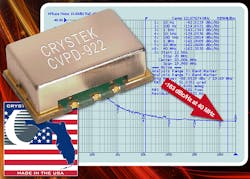VCXOs Quiet Phase Noise to -162 dBc/Hz
This file type includes high resolution graphics and schematics when applicable.
Phase noise is one of the limiting factors in receiver and transmitter performance in communications systems. Whether for analog or digital transmissions, excessive phase noise can cause side effects such as interference for closely spaced carriers and degradation of digital bit error rate (BER) performance.
To limit the phase noise at the starting point in a high-frequency signal conversion chain—the clock oscillator—Crystek recently introduced its CVPD-922 family of voltage-controlled crystal oscillators (VCXOs) with differential, low-voltage positive-emitter-coupled-logic (LVPECL) output signals. Available in a frequency range from 40 to 125 MHz, these “quiet” sources feature close-in single-sideband (SSB) phase noise of -85 dBc/Hz offset 10 Hz from the carrier, dropping to a noise floor of -162 dBc/Hz.
The CVPD-922 family of oscillators (see figure) provides a new degree of freedom for designers working on high-speed ECL-based circuits. Since ECL logic circuitry is extremely sensitive to noise, these oscillators provide a noise-floor limit that enables transmission of signals with higher signal integrity and improved BERs. The oscillators provide differential LVPECL outputs with worst-case 20-to-80% rise/fall time of 1 ns and ±10% linearity in support of logic signals with sharp pulse edges.
These are VCXOs with excellent time-domain performance and low noise to help achieve high levels of signal integrity in many different high-speed logic circuits. In the time domain, the typical phase jitter is just 85 fs at 100 MHz. In the frequency domain, the SSB phase noise drops steady from close to the carrier to offsets of 1 MHz and greater from the carrier (see table).
The crystal oscillators are available with a standard operating-temperature range of 0 to +70°C and with an operating-temperature range of -40 to +85°C as an option. They operate on a supply voltage of +3.3 ± 0.3 V dc with maximum current consumption of 88 mA. They are extremely stable with time, with an aging rate of less than 3 ppm during the first year of operation, and then less than 1 ppm per year after that. The oscillators conform to the applicable mechanical and environmental conditions of MIL-STD-883.
The CVPD-922 oscillators are supplied in surface-mount-device (SMD) housings measuring 0.560 × 0.360 × 0.210 in. (14.12 × 9.14 × 5.3 mm). They are available in tape-and-reel packaging for automated electronic manufacturing lines.
Crystek Crystals, a division of Crystek Corp., 12730 Commonwealth Dr., Fort Myers, FL 33913; (239) 561-3311, (800) 237-3061
Looking for parts? Go to SourceESB.
This file type includes high resolution graphics and schematics when applicable.
About the Author
Jack Browne
Technical Contributor
Jack Browne, Technical Contributor, has worked in technical publishing for over 30 years. He managed the content and production of three technical journals while at the American Institute of Physics, including Medical Physics and the Journal of Vacuum Science & Technology. He has been a Publisher and Editor for Penton Media, started the firm’s Wireless Symposium & Exhibition trade show in 1993, and currently serves as Technical Contributor for that company's Microwaves & RF magazine. Browne, who holds a BS in Mathematics from City College of New York and BA degrees in English and Philosophy from Fordham University, is a member of the IEEE.

